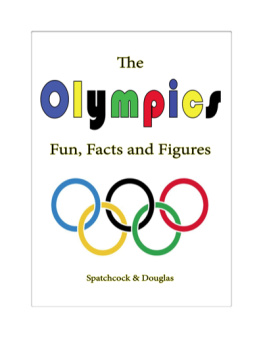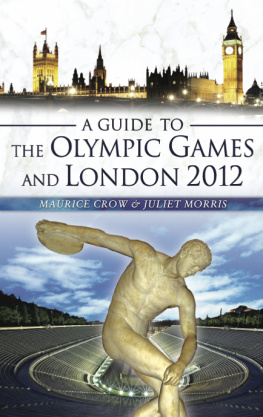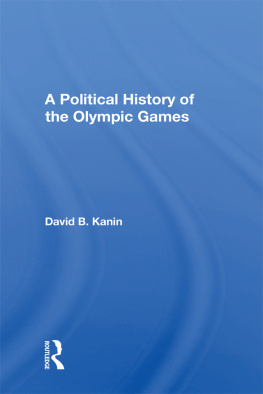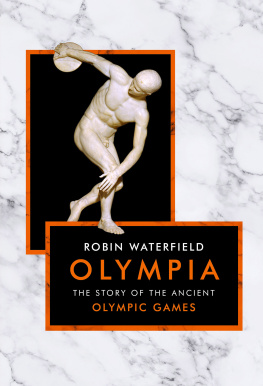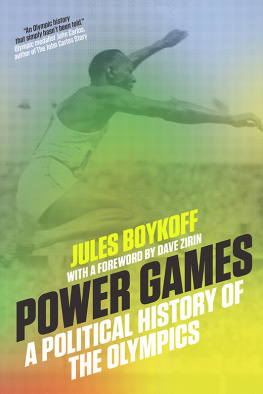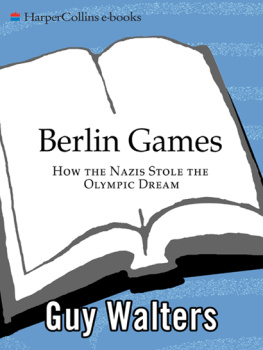Copyright
Copyright 1976 by M. I. Finley and H. W Pleket
All rights reserved.
Bibliographical Note
This Dover edition, first published in 2005, is an unabridged republication of the work originally published in 1976 by Chatto & Windus Ltd., London. The only significant alteration consists in reproducing the eight color plates in black and white in their original page positions, and in color, in somewhat reduced form, on the covers.
Library of Congress Cataloging-in-Publication Data
Finley, M. I. (Moses I.), 1912-
The Olympic Games : the first thousand years / M. I. Finley, H. W Pleket.Dover ed.
p. cm.
Originally published: London : Chatto and Windus, 1976.
Includes bibliographical references and index.
9780486149417
1. Olympic games (Ancient) I. Pleket, H. W., joint author. II. Title.
GV23.F56 2005
796.48dc22
2005045541
Manufactured in the United States of America
Dover Publications, Inc., 31 East 2nd Street, Mineola, N.Y 11501
Preface
The first modern Olympic Games, in Athens in 1896, were inspired, as the name indicates, by the ancient Games held every four years in a rather pastoral, wholly non-urban setting at Olympia in western Greece. In this book, we have tried to give a rounded picture of the ancient Games in the course of their thousand-year historythe site, the contests, the athletes and spectators, the politics and the ideals. Although we have abstained from drawing many comparisons, and certainly from pointing to lessons, the interests of the modern reader and the experience of the modern Olympics have always been in view. We have therefore not merely described and reported (in text and illustrations); we have also asked the questions that are bound to come to mind to a reader in the second half of the twentieth century, and we have tried to suggest answers when possible.
The original evidence about the Olympic Games, as about Games in general in the ancient world, is fragmentary and widely scattered. Some of it is literary, some archaeological and epigraphical. No one can claim to have examined every scrap, but we have personally studied a large proportion and we have tried not to overlook any important ancient document or modern discussion. We take full scholarly responsibility for what we have written, although we have only exceptionally indicated a source.
In the absence of bibliographical indications, we should like to record our indebtedness to colleagues whose publications we have found indispensable: on Olympia itself, H.-V. Herrmann and A. Mallwitz; on the Games and the athletes, Joachim Ebert, the late H. A. Harris, Reinhold Merkelbach, Luigi Moretti, Louis Robert, and the three great pioneers, E. N. Gardiner and Julius Jthner early in the present century, J. H. Krause in the nineteenth.
We should also like to thank Judy Lester for her assistance in procuring the illustrations and for the Index.
M. I. F.
H. W. P.
Table of Contents
Table of Figures
ACKNOWLEDGEMENTS
The authors and publishers wish to thank the following for permission to reproduce:
Antikenmuseum und Skulpturhalle, Basel: 2 (a).
Badisches Landesmuseum: 16 (a).
British Library Board: 26.
British Museum: 10 (a), 11 (a), 11 (b), 16 (b), 17 (a), 17 (b), 20, 21, 22 (b), 24 (c), 29 (a), 29 (b), 30 (a), 30 (b), IV and jacket, V (b), VII (b).
Professor O. Broneer: 18 (c).
Professor J. Dlorme and Editions E. de Boccard ( Gymnasion ): 28 (a).
Deutsches Archaeologisches Institut, Athens: 6 (b), 6 (d), 7 (a), 7 (b), 7 (c), 9 (b), 10 (c), 15 (b), 18 (a), 24 (b), 27.
Deutsches Archaeologisches Institut, Athens, and Prestel Verlag (A. Mallwitz, Olympia und seine Bauten ): 4-5.
Deutsches Archaeologisches Institut, Rome: 3 (b).
cole Franaise dArchologie, Athens: 25.
Fitzwilliam Museum: 6 (a), 10 (b), 23 (b), 23 (c), 23 (d), 30 (c).
Fogg Art Museum, Harvard University: Bequest of David M. Robinson (detail): 1 (b).
Fotomarburg: 6 (c), 19 (a).
Gabinetto Fotografico Nazionale, Rome: 31 (a).
Mrs. P. B. Gardiner and the Clarendon Press (E. N. Gardiner: Athletics of the Ancient World ): .
Greek Embassy Press and Information Office, London: 1 (a).
Mrs. H. A. Harris: 18 (b).
Professor H.-V. Herrmann and Carl Winter, Universittsverlag: Figs. 7-10.
Hirmer Fotoarchiv: 8 (a), 8 (b), 9 (a), 13, 14, 19 (b), 23 (a), 32, I, II (b), III (a).
Mansell Collection: II (a), VIII.
Martin Wagner Museum, Wrzburg: 31 (b).
Metropolitan Museum of Art, New York, Rogers Fund 1907: 12; Rogers Fund 1906: 22 (a); Rogers Fund 1914: VII (a) (14.130.12 Greek Vases).
Caecilia H. Moessner: III (b).
Muses Nationaux, Paris: 30 (d).
Museum of Fine Arts, Boston: 15 (a).
Rijksmuseum van Oudheden te Leiden: V (a) (PC8).
Staatliche Museen zu Berlin, DDR: VI and jacket.
Thames and Hudson Ltd. (Berve-Gruben-Hirmer: Greek Temples, Theatres and Shrines ): 28 (b)..,
Verlag der sterreichischen Akademie, Vienna (J. Jthner: Die athletische Leibesabungen der Griechen , 1968): (a) and (b).
Penguin Books Ltd.: The Odes of Pindar translated by C. M. Bowra (Penguin Classics 1969).
Note: Arabic numerals refer to the monochrome plates, and roman numerals refer to the colour plates.
A NOTE ON GREEK MEASURES OF DISTANCE AND MONEY VALUES
The ancient Greek measures of length were based primarily on parts of the body, with the foot as the main unit. Unfortunately, neither the foot nor its subdivisions and multiples were stable, varying both in place and in time. The stadion (Latin stadium ) was always 600 feet, and therefore varied according to the foot being used. At an early date the stadion became the standard distance for the sprint in racing, and soon the Stadium was also the race-track (but only in modern times an arena or sports-ground). Archaeological excavation has revealed that the Olympic stadion was 19227 metres in length, the one for the Pythian Games at Delphi 1775; others ranged from 1813 to 210 metres. For convenience, we have used round numbers in our text: 200 metres for the Olympic sprint and multiples of 200 for the longer races.
The monetary systems, based on weights, were equally varied. The main unit of weight, the mina , was too large to be coined (as was the tcclent , 60 minas, in which tribute was often expressed, for example). For coining, the basic unit was of a mina, called a drachma; the coins most frequently minted were the drachma, the 2-drachma piece (called didrachm or stater), the four-drachma piece (tetradrachm) and the obol ( of a drachma). The obol was usually coined in bronze, the others in silver. To appreciate the significance of the sums mentioned in this book, given the variations in local systems and in the purchasing power of money, we offer two comparative figures as guidelines: at the end of the fifth century B.C., each Athenian hoplite (heavy-armed infantryman) received a drachma a day while on duty, another for his batman, a sum which was then the average days pay for a skilled workman, on which (say 275-300 drachmas a year) the latter could maintain a small family; under the Roman Empire, when the drachma was conventionally equated to the Roman denarius , a soldiers annual pay ranged from 225 to 300 drachmas.
TABLE OF DATES
| B.C |
| before | Greek western colonizations begins |



